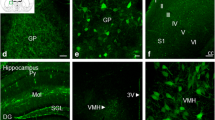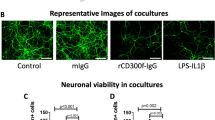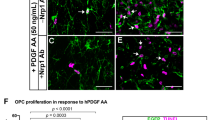Abstract
The CD200 ligand is expressed by a variety of cell types, including vascular endothelia, kidney glomeruli, some subsets of T and B cells, and neurons in the brain and periphery. In contrast, the receptor of CD200, CD200R, has a limited expression pattern and is mainly expressed by cells of myeloid origin. A recently solved crystal structure of the CD200–CD200R ectodomain complex suggests involvement of the first immunoglobulin (Ig)-like modules in ligand-receptor binding, resulting in the inhibition of myeloid cell function. In the central nervous system, CD200 has been implicated in the suppression of microglia activation. We for the first time demonstrated that CD200 can interact with and transduce signaling through activation of the fibroblast growth factor receptor (FGFR), thereby inducing neuritogenesis and promoting neuronal survival in primary neurons. CD200-induced FGFR phosphorylation was abrogated by CD200R, whereas FGF2-induced FGFR activation was inhibited by CD200. We also identified a sequence motif located in the first Ig-like module of CD200, likely representing the minimal CD200 binding site for FGFR. The FGFR binding motif overlaps with the CD200R binding site, suggesting that they can compete for CD200 binding in cells that express both receptors. We propose that CD200 in neurons functions as a ligand of FGFR.





Similar content being viewed by others
References
Chang RC, Chiu K, Ho YS, So KF (2009) Modulation of neuroimmune responses on glia in the central nervous system: implication in therapeutic intervention against neuroinflammation. Cell Mol Immunol 6:317–326
Lue LF, Kuo YM, Beach T, Walker DG (2010) Microglia activation and anti-inflammatory regulation in Alzheimer’s disease. Mol Neurobiol 41:115–128
Wright GJ, Jones M, Puklavec MJ, Brown MH, Barclay AN (2001) The unusual distribution of the neuronal/lymphoid cell surface CD200 (OX2) glycoprotein is conserved in humans. Immunology 102:173–179
Wright GJ, Puklavec MJ, Willis AC, Hoek RM, Sedgwick JD, Brown MH, Barclay AN (2000) Lymphoid/neuronal cell surface OX2 glycoprotein recognizes a novel receptor on macrophages implicated in the control of their function. Immunity 13:233–242
Wright GJ, Cherwinski H, Foster-Cuevas M, Brooke G, Puklavec MJ, Bigler M, Song Y, Jenmalm M, Gorman D, McClanahan T, Liu MR, Brown MH, Sedgwick JD, Phillips JH, Barclay AN (2003) Characterization of the CD200 receptor family in mice and humans and their interactions with CD200. J Immunol 171:3034–3046
Zhang S, Cherwinski H, Sedgwick JD, Phillips JH (2004) Molecular mechanisms of CD200 inhibition of mast cell activation. J Immunol 173:6786–6793
Mihrshahi R, Barclay AN, Brown MH (2009) Essential roles for Dok2 and RasGAP in CD200 receptor-mediated regulation of human myeloid cells. J Immunol 183:4879–4886
Hatherley D, Lea SM, Johnson S, Barclay AN (2013) Structures of CD200/CD200 receptor family and implications for topology, regulation, and evolution. Structure 21:820–832
Hoek RM, Ruuls SR, Murphy CA, Wright GJ, Goddard R, Zurawski SM, Blom B, Homola ME, Streit WJ, Brown MH, Barclay AN, Sedgwick JD (2000) Down-regulation of the macrophage lineage through interaction with OX2 (CD200). Science 290:1768–1771
Jenmalm MC, Cherwinski H, Bowman EP, Phillips JH, Sedgwick JD (2006) Regulation of myeloid cell function through the CD200 receptor. J Immunol 176:191–199
Cherwinski HM, Murphy CA, Joyce BL, Bigler ME, Song YS, Zurawski SM, Moshrefi MM, Gorman DM, Miller KL, Zhang S, Sedgwick JD, Phillips JH (2005) The CD200 receptor is a novel and potent regulator of murine and human mast cell function. J Immunol 174:1348–1356
Webb M, Barclay AN (1984) Localisation of the MRC OX-2 glycoprotein on the surfaces of neurones. J Neurochem 43:1061–1067
Koning N, Swaab DF, Hoek RM, Huitinga I (2009) Distribution of the immune inhibitory molecules CD200 and CD200R in the normal central nervous system and multiple sclerosis lesions suggests neuron-glia and glia-glia interactions. J Neuropathol Exp Neurol 68:159–167
Chitnis T, Imitola J, Wang Y, Elyaman W, Chawla P, Sharuk M, Raddassi K, Bronson RT, Khoury SJ (2007) Elevated neuronal expression of CD200 protects Wlds mice from inflammation-mediated neurodegeneration. Am J Pathol 170:1695–1712
Boudakov I, Liu J, Fan N, Gulay P, Wong K, Gorczynski RM (2007) Mice lacking CD200R1 show absence of suppression of lipopolysaccharide-induced tumor necrosis factor-alpha and mixed leukocyte culture responses by CD200. Transplantation 84:251–257
Zhang S, Wang XJ, Tian LP, Pan J, Lu GQ, Zhang YJ, Ding JQ, Chen SD (2011) CD200–CD200R dysfunction exacerbates microglial activation and dopaminergic neurodegeneration in a rat model of Parkinson’s disease. J Neuroinflammation 8:154
Costello DA, Lyons A, Denieffe S, Browne TC, Cox FF, Lynch MA (2011) Long term potentiation is impaired in membrane glycoprotein CD200-deficient mice: a role for Toll-like receptor activation. J Biol Chem 286:34722–34732
Cox FF, Carney D, Miller AM, Lynch MA (2012) CD200 fusion protein decreases microglial activation in the hippocampus of aged rats. Brain Behav Immun 26:789–796
Ojo B, Rezaie P, Gabbott PL, Davies H, Colyer F, Cowley TR, Lynch M, Stewart MG (2012) Age-related changes in the hippocampus (loss of synaptophysin and glial-synaptic interaction) are modified by systemic treatment with an NCAM-derived peptide, FGL. Brain Behav Immun 26:778–788
Pankratova S, Gu B, Kiryushko D, Korshunova I, Kohler LB, Rathje M, Bock E, Berezin V (2012) A new agonist of the erythropoietin receptor, Epobis, induces neurite outgrowth and promotes neuronal survival. J Neurochem 121:915–923
Williams EJ, Furness J, Walsh FS, Doherty P (1994) Activation of the FGF receptor underlies neurite outgrowth stimulated by L1, N-CAM, and N-cadherin. Neuron 13:583–594
Kiselyov VV, Skladchikova G, Hinsby AM, Jensen PH, Kulahin N, Soroka V, Pedersen N, Tsetlin V, Poulsen FM, Berezin V, Bock E (2003) Structural basis for a direct interaction between FGFR1 and NCAM and evidence for a regulatory role of ATP. Structure 11:691–701
Owczarek S, Kiryushko D, Larsen MH, Kastrup JS, Gajhede M, Sandi C, Berezin V, Bock E, Soroka V (2010) Neuroplastin-55 binds to and signals through the fibroblast growth factor receptor. FASEB J 24:1139–1150
Bojesen KB, Clausen O, Rohde K, Christensen C, Zhang L, Li S, Kohler L, Nielbo S, Nielsen J, Gjorlund MD, Poulsen FM, Bock E, Berezin V (2012) Nectin-1 binds and signals through the fibroblast growth factor receptor. J Biol Chem 287:37420–37433
Neiiendam JL, Kohler LB, Christensen C, Li S, Pedersen MV, Ditlevsen DK, Kornum MK, Kiselyov VV, Berezin V, Bock E (2004) An NCAM-derived FGF-receptor agonist, the FGL-peptide, induces neurite outgrowth and neuronal survival in primary rat neurons. J Neurochem 91:920–935
Li S, Christensen C, Kohler LB, Kiselyov VV, Berezin V, Bock E (2009) Agonists of fibroblast growth factor receptor induce neurite outgrowth and survival of cerebellar granule neurons. Dev Neurobiol 69:837–854
Hatherley D, Cherwinski HM, Moshref M, Barclay AN (2005) Recombinant CD200 protein does not bind activating proteins closely related to CD200 receptor. J Immunol 175:2469–2474
Williams AF, Gagnon J (1982) Neuronal cell Thy-1 glycoprotein: homology with immunoglobulin. Science 216:696–703
Murata T, Ohnishi H, Okazawa H, Murata Y, Kusakari S, Hayashi Y, Miyashita M, Itoh H, Oldenborg PA, Furuya N, Matozaki T (2006) CD47 promotes neuronal development through Src- and FRG/Vav2-mediated activation of Rac and Cdc42. J Neurosci 26:12397–12407
Fossum S, Mallett S, Barclay AN (1991) The MRC OX-47 antigen is a member of the immunoglobulin superfamily with an unusual transmembrane sequence. Eur J Immunol 21:671–679
Tanaka H, Matsui T, Agata A, Tomura M, Kubota I, McFarland KC, Kohr B, Lee A, Phillips HS, Shelton DL (1991) Molecular cloning and expression of a novel adhesion molecule, SC1. Neuron 7:535–545
Bowen MA, Patel DD, Li X, Modrell B, Malacko AR, Wang WC, Marquardt H, Neubauer M, Pesando JM, Francke U (1995) Cloning, mapping, and characterization of activated leukocyte-cell adhesion molecule (ALCAM), a CD6 ligand. J Exp Med 181:2213–2220
Hortsch M (1996) The L1 family of neural cell adhesion molecules: old proteins performing new tricks. Neuron 17:587–593
Kulahin N, Li S, Hinsby A, Kiselyov V, Berezin V, Bock E (2008) Fibronectin type III (FN3) modules of the neuronal cell adhesion molecule L1 interact directly with the fibroblast growth factor (FGF) receptor. Mol Cell Neurosci 37:528–536
Li S, Bock E, Berezin V (2010) Neuritogenic and neuroprotective properties of peptide agonists of the fibroblast growth factor receptor. Int J Mol Sci 11:2291–2305
Gjørlund MD, Nielsen J, Pankratova S, Li S, Korshunova I, Bock E, Berezin V (2012) Neuroligin-1 induces neurite outgrowth through interaction with neurexin-1β and activation of fibroblast growth factor receptor-1. FASEB J 26:4174–4186
Sanchez-Heras E, Howell FV, Williams G, Doherty P (2006) The fibroblast growth factor receptor acid box is essential for interactions with N-cadherin and all of the major isoforms of neural cell adhesion molecule. J Biol Chem 281:35208–35216
Kirschbaum K, Kriebel M, Kranz EU, Potz O, Volkmer H (2009) Analysis of non-canonical fibroblast growth factor receptor 1 (FGFR1) interaction reveals regulatory and activating domains of neurofascin. J Biol Chem 284:28533–28542
Kiselyov VV, Soroka V, Berezin V, Bock E (2005) Structural biology of NCAM homophilic binding and activation of FGFR. J Neurochem 94:1169–1179
Leclair P, Lim CJ (2014) CD47-independent effects mediated by the TSP-derived 4N1K peptide. PLoS ONE 9:e98358
Rygiel TP, Meyaard L (2012) CD200R signaling in tumor tolerance and inflammation: a tricky balance. Curr Opin Immunol 24:233–238
Moldovan M, Pinchenko V, Dmytriyeva O, Pankratova S, Fugleholm K, Klingelhofer J, Bock E, Berezin V, Krarup C, Kiryushko D (2013) Peptide mimetic of the S100A4 protein modulates peripheral nerve regeneration and attenuates the progression of neuropathy in myelin protein P0 null mice. Mol Med 19:43–53
Christensen C, Berezin V, Bock E (2011) Neural cell adhesion molecule differentially interacts with isoforms of the fibroblast growth factor receptor. Neuroreport 22:727–732
Acknowledgments
We thank Dr. S. Owczarek for providing with cortical neurons and Dr. V. Soroka for helping with binding data analysis. This project was supported by the Lundbeck Foundation, Danish Medical Research Council, and Dagmar Marshalls Fond. The authors declare that they have no conflict of interest.
Author information
Authors and Affiliations
Corresponding author
Additional information
S.P and H.B. contributed equally to this work.
Rights and permissions
About this article
Cite this article
Pankratova, S., Bjornsdottir, H., Christensen, C. et al. Immunomodulator CD200 Promotes Neurotrophic Activity by Interacting with and Activating the Fibroblast Growth Factor Receptor. Mol Neurobiol 53, 584–594 (2016). https://doi.org/10.1007/s12035-014-9037-6
Received:
Accepted:
Published:
Issue Date:
DOI: https://doi.org/10.1007/s12035-014-9037-6




